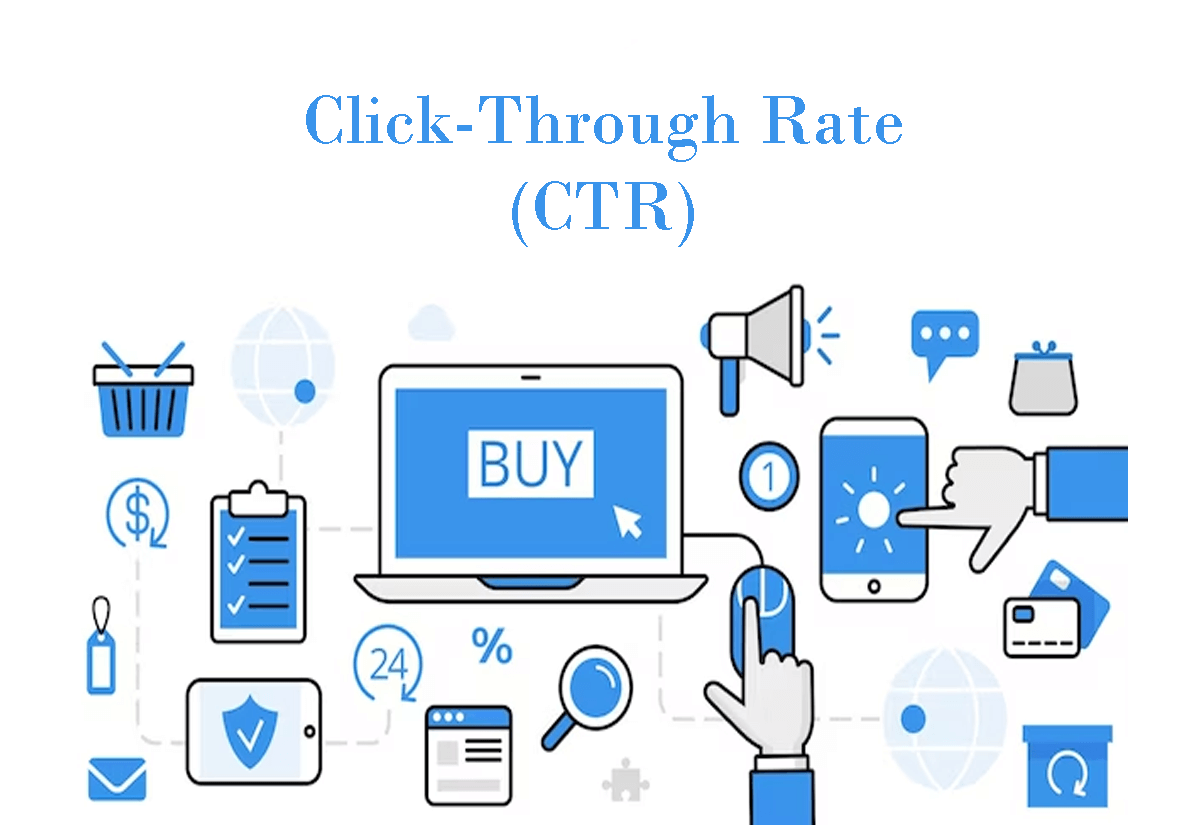What's Inside?
Click-through rate (CTR) is a metric used in online advertising and marketing to measure the effectiveness of an advertisement or a call-to-action in generating clicks or user engagement. It is expressed as a percentage and represents the ratio of users who click on a specific link or advertisement to the total number of users who view it.
CTR is commonly associated with online display ads, search engine advertising, email marketing, and other digital marketing channels. It is calculated by dividing the number of clicks on an ad by the number of impressions (or views) it receives and multiplying the result by 100.
CTR = (Clicks / Impressions) x 100
For example, if an advertisement receives 500 clicks and 10,000 impressions, the CTR would be:
CTR = (500 / 10,000) x 100 = 5%
A higher click-through rate generally indicates that the ad or link is more appealing and engaging to users. Advertisers often aim to optimize their campaigns to achieve higher CTRs as it can result in increased traffic, conversions, and ultimately a higher return on investment (ROI). However, it’s important to consider other metrics such as conversion rate and engagement to assess the overall success of a marketing campaign.
Why CTR is important
Click-through rate (CTR) is important for several reasons in the context of online advertising and marketing:
- Measure of Ad Effectiveness: CTR provides insights into how well an advertisement or call-to-action is resonating with the target audience. A higher CTR suggests that the ad is compelling and relevant to users, leading to a higher likelihood of engagement and conversions.
- Ad Ranking: In certain advertising platforms, such as search engine advertising (e.g., Google Ads), CTR plays a significant role in determining ad rankings. Ads with higher CTRs are often rewarded with better positions on search engine result pages, increasing visibility and potential reach.
- Cost Efficiency: A higher CTR can lead to improved cost efficiency in advertising campaigns. When ads have a higher CTR, it means more users are clicking on them relative to the number of impressions. This indicates that the ad is effectively targeting the right audience, resulting in lower costs per click or conversion.
- Ad Relevance and Quality Score: Some advertising platforms consider CTR as a factor in determining the relevance and quality score of an ad. A higher CTR indicates that the ad is resonating with users, which can positively influence its quality score. A higher quality score can, in turn, lead to lower costs and better ad placement.
- Performance Comparison: CTR allows marketers to compare the performance of different ads, campaigns, or variations of creative elements (such as headlines, images, or calls-to-action). By analyzing CTRs, marketers can identify what works best and optimize their strategies accordingly.
- Feedback for Ad Optimization: A low CTR can indicate that an ad may need optimization. By monitoring CTRs, marketers can identify underperforming ads and make adjustments to improve their effectiveness. This can involve refining ad copy, targeting specific audience segments, or testing different creative elements.
While CTR is an essential metric, it should not be the sole factor for evaluating the success of an advertising campaign. It is important to consider other metrics like conversion rate, engagement, and return on investment (ROI) to gain a comprehensive understanding of the campaign’s effectiveness.
What’s a good click-through rate?
 The notion of a “good” click-through rate (CTR) can vary depending on the industry, advertising platform, and specific context. What might be considered a high CTR in one situation could be average or even low in another. However, as a general guideline, an average CTR for display ads is around 0.1% to 0.2%, while for search engine ads, it typically ranges from 1% to 2%.
The notion of a “good” click-through rate (CTR) can vary depending on the industry, advertising platform, and specific context. What might be considered a high CTR in one situation could be average or even low in another. However, as a general guideline, an average CTR for display ads is around 0.1% to 0.2%, while for search engine ads, it typically ranges from 1% to 2%.
Keep in mind that CTR benchmarks can differ based on factors such as:
- Industry: Different industries may have varying levels of competition, audience engagement, or ad formats that influence CTR. For example, industries like finance or technology might have lower average CTRs due to higher competition, while niches with more targeted audiences could potentially have higher CTRs.
- Ad Placement: CTR can vary depending on where the ad is displayed. Ads placed in prominent positions on search engine result pages or websites may generally have higher CTRs compared to those in less visible locations.
- Ad Format and Creative: The format and design of the ad can impact CTR. Certain ad formats, such as video or interactive ads, may have different engagement rates compared to standard display or text ads. Additionally, the quality of ad copy, images, and calls-to-action can influence CTR.
- Target Audience: The preferences and behaviors of the target audience can affect CTR. Ads that align well with the interests and needs of the target audience are more likely to generate higher CTRs.
While industry benchmarks and average CTRs can provide a starting point for evaluation, it’s crucial to set realistic goals based on your specific advertising objectives and context. The focus should be on improving and optimizing CTR over time, rather than striving for a specific benchmark. Comparing CTR performance across different campaigns or iterations of ads within your own marketing efforts can be more valuable in assessing progress and making informed decisions.
Tips to improve CTR
To improve your click-through rate (CTR) and increase user engagement with your ads or content, consider implementing the following tips:
- Target the Right Audience: Ensure that your ads are being displayed to a relevant audience that is more likely to be interested in your offer. Utilize precise targeting options such as demographics, interests, and location to reach the most relevant users.
- Compelling and Clear Headlines: Craft attention-grabbing headlines that clearly convey the value proposition or the key message of your ad. Use strong and persuasive language to entice users to click and learn more.
- Engaging Ad Copy: Write concise, compelling, and benefit-focused ad copy that highlights the unique selling points of your product or service. Make sure it resonates with the target audience and addresses their pain points or desires.
- Clear Call-to-Action (CTA): Use a clear and actionable CTA that prompts users to take the desired action. Whether it’s “Buy Now,” “Learn More,” “Sign Up,” or any other CTA, make it stand out and compelling.
- Ad Placement and Design: Consider the placement of your ads on websites or search engine result pages. Ads placed in prominent positions tend to receive more attention and clicks. Additionally, use visually appealing and relevant images or graphics that grab attention and enhance the overall ad experience.
- A/B Testing: Test different variations of your ads, including headlines, copy, CTAs, and visuals, to identify what resonates best with your audience. A/B testing helps you optimize your ads and make data-driven decisions to improve CTR.
- Ad Extensions: Take advantage of ad extensions provided by advertising platforms. Ad extensions can provide additional information or options to users, increasing the visibility and appeal of your ad.
- Mobile Optimization: With the rise of mobile devices, ensure that your ads are optimized for mobile viewing and interaction. Responsive design, fast loading times, and clear CTA buttons are crucial for mobile ad success.
- Ad Relevance: Ensure that your ads align with the landing page or content users are directed to after clicking. The ad should deliver on the promise made in the ad copy to avoid disappointment and maintain user trust.
- Continuous Monitoring and Optimization: Regularly monitor the performance of your ads and make data-driven optimizations based on the insights gained. Track metrics, such as CTR, conversion rate, and engagement, to understand what is working and what needs improvement.
Remember that improving CTR is an ongoing process that requires experimentation, analysis, and refinement. By implementing these tips and continuously optimizing your ads, you can enhance CTR and drive better results in your advertising campaigns.
How to Calculate the Click-Through Rate
To calculate the click-through rate (CTR), you need two pieces of data: the number of clicks and the number of impressions. The formula to calculate CTR is as follows:
CTR = (Clicks / Impressions) x 100
Here’s a step-by-step guide on how to calculate CTR:
- Determine the number of clicks: This refers to the total number of times users clicked on your ad or link. This information is typically provided by the platform or advertising tool you are using, such as Google Ads, Facebook Ads Manager, or your website analytics.
- Determine the number of impressions: Impressions refer to the number of times your ad or link was shown or displayed to users. It represents the total number of opportunities for users to view your ad. The impression data can also be obtained from the advertising platform or analytics tool you are using.
- Divide the number of clicks by the number of impressions: Take the number of clicks and divide it by the number of impressions.
- Multiply the result by 100: Multiply the quotient from step 3 by 100 to convert it to a percentage.
The resulting value is the click-through rate expressed as a percentage. For example, if you have 500 clicks and 10,000 impressions, the calculation would be as follows:
CTR = (500 / 10,000) x 100 = 5%
In this example, the CTR would be 5%. This means that out of every 100 impressions, approximately 5 users clicked on the ad or link.
What Does the Click-Through Rate Tell You?
 The click-through rate (CTR) provides valuable insights into the performance and effectiveness of your ads, links, or call-to-action. Here’s what the CTR can tell you:
The click-through rate (CTR) provides valuable insights into the performance and effectiveness of your ads, links, or call-to-action. Here’s what the CTR can tell you:
- Ad or Link Relevance: A higher CTR indicates that your ad or link is relevant and compelling to the target audience. It suggests that users found the content appealing and were motivated to click on it, demonstrating that your messaging and targeting are resonating with users.
- Ad Engagement: CTR measures the level of user engagement with your ad. A higher CTR indicates that users are actively interacting with your ad and taking the desired action by clicking on it. It suggests that your ad is capturing attention and generating interest among users.
- Ad Effectiveness: CTR is a measure of how well your ad or link is performing in generating clicks. A higher CTR suggests that your ad is effective in driving user engagement and attracting clicks. It can be an indicator of an ad’s success in achieving its goals, such as driving traffic to a website or increasing conversions.
- Ad Position and Visibility: CTR can provide insights into the positioning and visibility of your ad. Higher CTRs may indicate that your ad is placed in prominent positions, such as the top of search engine results or within highly visible areas of a webpage. It suggests that your ad is receiving more exposure and attracting user attention.
- Ad Copy and Design Effectiveness: CTR can help evaluate the effectiveness of your ad copy and design elements. By comparing CTRs across different ads or variations, you can assess which headlines, copywriting styles, visuals, or CTAs are more compelling to users. This information can inform future ad creative decisions and optimization efforts.
- Campaign Performance: CTR is an important metric for monitoring and evaluating the overall performance of your advertising campaigns. By tracking CTR over time, you can identify trends, assess campaign effectiveness, and make data-driven decisions to optimize your strategies.
- Comparison and Benchmarking: CTR allows you to compare the performance of different ads, campaigns, or channels. By benchmarking against industry averages or your own historical data, you can assess how your ads are performing relative to expectations or competitors.
It’s important to note that while CTR provides insights into user engagement and ad performance, it should be considered alongside other metrics such as conversion rate, cost per click, and return on investment (ROI) to gain a comprehensive understanding of the effectiveness of your advertising efforts.
Difference Between Click-Through Rate and Conversion Rate
Click-through rate (CTR) and conversion rate are both important metrics in online advertising and marketing, but they measure different aspects of user behavior and campaign performance. Here’s the difference between CTR and conversion rate:
- Click-Through Rate (CTR): CTR measures the percentage of users who click on a specific ad, link, or call-to-action out of the total number of impressions or views. It shows how successful your ad is in generating user interest and engagement. CTR is calculated by dividing the number of clicks by the number of impressions and multiplying the result by 100.
CTR = (Clicks / Impressions) x 100
CTR helps assess the effectiveness of your ad in capturing attention, generating clicks, and driving traffic to a landing page or website. It primarily focuses on the initial interaction and the number of users who take the action of clicking.
- Conversion Rate: Conversion rate measures the percentage of users who complete a desired action or goal (such as making a purchase, filling out a form, or subscribing) out of the total number of visitors or users. It reflects how successful your ad or marketing campaign is in achieving its intended objectives and driving desired outcomes.
Conversion Rate = (Conversions / Total Visitors) x 100
Conversion rate looks beyond the initial click and focuses on the subsequent actions taken by users, representing the effectiveness of your landing page, offer, and overall user experience. It indicates the rate at which users convert from being visitors to becoming customers or taking other desired actions.
While CTR indicates the level of engagement and interest generated by an ad, conversion rate reflects the effectiveness of the entire user journey, including the landing page, value proposition, user interface, and persuasive elements that drive users to complete a specific action.
Both CTR and conversion rate are important metrics, but they serve different purposes and provide insights into different aspects of your advertising and marketing efforts. Monitoring and optimizing both metrics can help you assess and improve the overall performance and success of your campaigns.
How CTR Impacts Ad Rank
In certain advertising platforms like Google Ads, click-through rate (CTR) can impact ad rank, which determines the position and visibility of your ads on search engine result pages (SERPs). Here’s how CTR can influence ad rank:
- Quality Score: Quality Score is a metric used by Google Ads to assess the quality and relevance of your ads and keywords. CTR is a component of the Quality Score calculation. Ads with higher CTRs are seen as more relevant and useful to users, which can lead to higher Quality Scores. A higher Quality Score can, in turn, positively impact ad rank.
- Expected Click-Through Rate (eCTR): Google Ads uses historical CTR data for ads with similar keywords and placements to estimate the expected click-through rate (eCTR) for your ads. If your actual CTR exceeds the eCTR, it signals that your ad is performing well, which can lead to improved ad rank.
- Ad Extensions and Formats: Ad extensions, such as site links, callouts, and structured snippets, can improve the visibility and attractiveness of your ads. When extensions are displayed, they can occupy more space and provide additional information, which can increase the likelihood of clicks. Higher CTRs resulting from ad extensions can positively impact ad rank.
- Advertiser Competition: CTR can indirectly impact ad rank through competition. When multiple advertisers are targeting the same keywords or audience, CTR can be a determining factor in ad position. Ads with higher CTRs tend to have better ad rank and placement, allowing them to appear above ads with lower CTRs.
- Ad Relevance: Google Ads aims to provide relevant and valuable search results to users. CTR is an indicator of how well your ad matches the user’s search intent. Higher CTRs suggest better relevance, which can positively influence ad rank.
It’s important to note that while CTR is a significant factor, it is not the sole determinant of ad rank. Other factors, such as bid amount, landing page experience, ad relevance, and overall campaign performance, also play a role in determining ad position.
Optimizing your ads for higher CTRs by focusing on ad relevance, engaging ad copy, compelling CTAs, and relevant extensions can positively impact ad rank and improve the visibility and performance of your ads on search engine result pages.
What Affects Click-Through Rate?
 Several factors can affect the click-through rate (CTR) of your ads or links. Understanding these factors can help you optimize your campaigns to improve CTR. Here are some key factors that influence CTR:
Several factors can affect the click-through rate (CTR) of your ads or links. Understanding these factors can help you optimize your campaigns to improve CTR. Here are some key factors that influence CTR:
- Ad Relevance: The relevance of your ad to the target audience is crucial. Ads that align well with the user’s search query, interests, and needs are more likely to generate higher CTRs. Ensuring that your ad copy, keywords, and targeting are closely aligned with the user’s intent can improve relevance and increase the likelihood of clicks.
- Ad Position and Visibility: The position of your ad on a webpage or search engine result page can significantly impact CTR. Ads displayed in prominent positions, such as the top of the page or above the fold, tend to receive more attention and clicks. Aim for higher ad positions to increase visibility and maximize CTR.
- Ad Copy and Creative Elements: The quality and effectiveness of your ad copy, headlines, images, and calls-to-action (CTAs) can influence CTR. Compelling and engaging ad copy that highlights the unique selling points, benefits, or offers can attract user attention and prompt them to click. Clear and enticing CTAs can also improve CTR by encouraging users to take action.
- Targeting and Audience Segmentation: Understanding your target audience and effectively targeting them can impact CTR. The more precisely you can define and reach your desired audience, the higher the chances of generating clicks from users who are more likely to be interested in your offer. Utilize targeting options such as demographics, interests, and location to optimize audience relevance and improve CTR.
- Ad Format and Placement: The format and placement of your ads can affect CTR. Different ad formats, such as text ads, display ads, or video ads, can have varying levels of engagement. Additionally, the placement of your ads within a webpage or app can impact visibility and clickability. Experimenting with different ad formats and placements can help determine what works best for your audience.
- Ad Frequency and Fatigue: Displaying your ads too frequently to the same audience can lead to ad fatigue, resulting in lower CTR. Users may become less responsive to repetitive ads. Ensure that you manage ad frequency and reach a balance that maintains user interest and engagement.
- Mobile Optimization: With the increasing use of mobile devices, optimizing your ads for mobile viewing is crucial. Mobile-responsive design, fast loading times, and user-friendly interfaces can improve the user experience, making it easier for mobile users to click on your ads and improve CTR.
- Competitor Landscape: The level of competition in your industry or niche can impact CTR. If there are many advertisers targeting similar keywords or audience segments, it can affect the visibility and competitiveness of your ads. Monitoring your competitors and adjusting your ad strategy accordingly can help improve CTR.
By considering and optimizing these factors, you can increase the likelihood of generating higher click-through rates and drive better results from your advertising campaigns. It’s important to continuously test and refine your approach based on data and user feedback to optimize CTR over time.
What Is the Difference Between CTR for PPC and Organic Search?
The click-through rate (CTR) can be measured in both paid search (PPC) and organic search, but there are some fundamental differences between the two. Here’s a breakdown of the differences:
- Paid Search (PPC) CTR: In paid search advertising, businesses bid on keywords and create ads that appear at the top or bottom of search engine result pages (SERPs) or on other websites. The CTR in PPC refers to the percentage of users who click on a paid ad out of the total number of ad impressions. It indicates the effectiveness of the ad in generating clicks. PPC ads are labeled as “sponsored” or “ad” and typically appear above or below the organic search results.
- Organic Search CTR: Organic search refers to the non-paid, natural search results that appear on SERPs. The CTR in organic search refers to the percentage of users who click on an organic search result out of the total number of impressions. Organic search CTR provides insights into the appeal and relevance of the organic search listings to users.
Here are some key differences between PPC and organic search CTR:
Visibility: In PPC, ads are displayed prominently at the top or bottom of the SERPs, often with ad extensions and additional formatting. This high visibility can result in higher CTRs for PPC ads compared to organic search results, which may be lower on the page.
Control: In PPC, advertisers have more control over the ad copy, messaging, and landing page experience, allowing them to optimize for higher CTRs. In organic search, the search engine algorithm determines the snippets displayed for each result based on the page content, which may impact CTR.
Cost: PPC ads require advertisers to pay for each click generated, whereas organic search clicks are free. The CTR in PPC can impact costs directly, as higher CTRs can result in lower cost-per-click (CPC) and better return on ad spend (ROAS). Organic search CTR does not have a direct cost implication.
Competition: PPC ads compete for ad positions based on factors like bid amounts, ad quality, and relevance. Higher competition among advertisers can impact CTR as well as the cost and placement of the ads. Organic search results are influenced by search engine algorithms and website authority, which can affect organic CTR.
Intent: Users’ intent may differ when they interact with PPC ads compared to organic search results. PPC ads often target commercial intent, where users may be more likely to click and convert. Organic search results cater to various user intents, including informational, navigational, and transactional, which can affect CTR.
Both PPC and organic search CTRs provide valuable insights into user behavior and the effectiveness of your search marketing efforts. Monitoring and optimizing both metrics can help you understand the performance of your paid and organic strategies and make data-driven decisions to improve CTR and overall campaign success.


